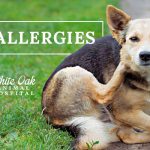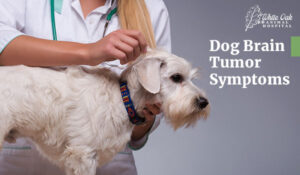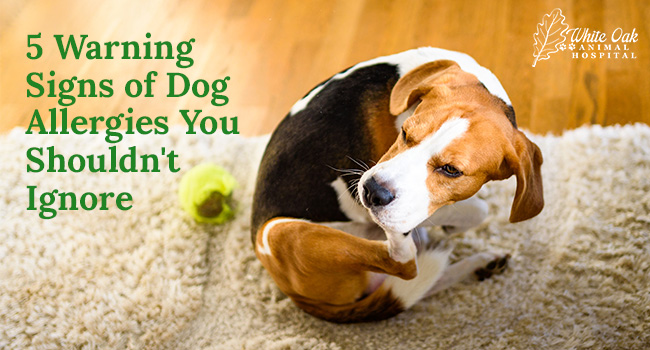
Canine health is significantly impacted by dog allergies, a prevalent concern among pet owners. Recognizing and promptly addressing allergic reactions in dogs is crucial for their well-being. Allergies in dogs can manifest in various ways, ranging from skin irritations to gastrointestinal and respiratory problems.
If left unaddressed, these allergic reactions can cause discomfort and distress to our beloved pets. Therefore, pet owners must be vigilant and observant of any signs indicating allergic reactions in their dogs. By understanding the common allergens affecting dogs and being proactive in seeking veterinary care, pet owners can effectively manage dog allergies and ensure the health and happiness of their canine companions.
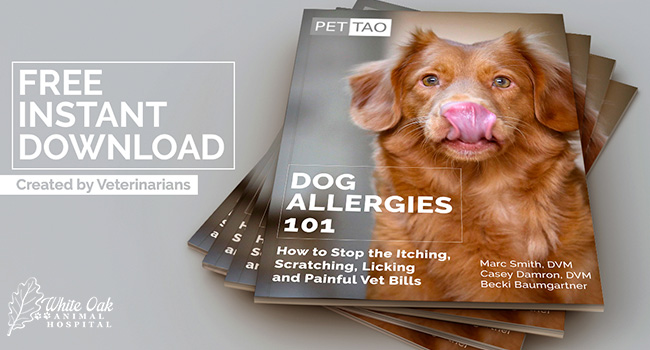
Understanding Dog Allergies
 Dog allergies can stem from various environmental factors and specific food ingredients, leading to symptoms like itching, sneezing, and watery eyes. Certain food ingredients like grains, proteins, and artificial additives can also provoke allergic responses in sensitive dogs.
Dog allergies can stem from various environmental factors and specific food ingredients, leading to symptoms like itching, sneezing, and watery eyes. Certain food ingredients like grains, proteins, and artificial additives can also provoke allergic responses in sensitive dogs.
Allergies in dogs often manifest through various symptoms affecting the skin, respiratory system, and digestive tract. Common signs of dog allergies include itching, redness, inflammation, hair loss, coughing, sneezing, vomiting, and diarrhea. These symptoms may vary in severity and can significantly impact the quality of life for affected dogs. Recognizing these signs and seeking veterinary advice promptly is crucial for managing dog allergies effectively and ensuring the well-being of our canine companions.
Breed Susceptibility
 Certain dog breeds may be more susceptible to allergies due to genetic predispositions and breed-specific characteristics. Breeds predisposed to skin issues, such as Bulldogs, Retrievers, and Terriers, may be more prone to allergic reactions. Additionally, breeds with folded skin or excessive facial skin folds, like Bulldogs and Shar-Peis, may experience allergies related to moisture and bacterial growth in these areas.
Certain dog breeds may be more susceptible to allergies due to genetic predispositions and breed-specific characteristics. Breeds predisposed to skin issues, such as Bulldogs, Retrievers, and Terriers, may be more prone to allergic reactions. Additionally, breeds with folded skin or excessive facial skin folds, like Bulldogs and Shar-Peis, may experience allergies related to moisture and bacterial growth in these areas.
However, it’s essential to note that allergies can affect dogs of any breed or mix, and individual factors such as age, environment, and overall health also play significant roles. Understanding breed tendencies can help pet owners recognize potential allergy risks in their dogs and take proactive measures to effectively manage and mitigate allergic reactions.
Potential Triggers
 Various factors, including environmental elements and food sensitivities, can trigger allergic reactions in dogs. Environmental factors such as pollen, dust mites, mold spores, and flea saliva are common culprits for provoking allergic responses in dogs.
Various factors, including environmental elements and food sensitivities, can trigger allergic reactions in dogs. Environmental factors such as pollen, dust mites, mold spores, and flea saliva are common culprits for provoking allergic responses in dogs.
Additionally, certain food ingredients, such as beef, chicken, dairy, wheat, and soy, can trigger allergic reactions in some dogs. Identifying these potential triggers is crucial for effectively managing dog allergies. Pet owners should be vigilant in observing their dog’s symptoms and behavior to pinpoint specific allergens.
Consultation with a veterinarian may be necessary to conduct allergy testing and determine the most appropriate course of action. By identifying and addressing potential triggers, pet owners can help alleviate their dog’s allergic symptoms and improve their overall quality of life.
5 Warning Signs of Dog Allergies You Shouldn’t Ignore
Skin Irritations and Redness
Skin irritations and redness are frequent indicators of allergic reactions in dogs. Allergens can trigger inflammation and discomfort, leading to visible changes in the skin’s appearance. Redness, swelling, and hot spots are common signs that suggest an allergic response. Hot spots, in particular, are localized areas of inflamed and infected skin that can cause intense itching and discomfort.
These symptoms may occur on various body parts, including the paws, ears, abdomen, and groin. Pet owners should monitor their dog’s skin condition regularly and seek veterinary attention if they notice persistent redness, irritation, or unusual skin texture changes. Early intervention is crucial for managing dog allergies effectively and ensuring the well-being of the canine companion.
Persistent Itching and Scratching
 Excessive itching and scratching are common indications of allergic reactions in dogs. When a dog constantly scratches or chews on its skin, it could be a sign of discomfort caused by allergies. This behavior often targets specific areas, such as the paws, ears, groin, or underarms. Persistent scratching may lead to skin irritation, redness, inflammation, and even secondary infections.
Excessive itching and scratching are common indications of allergic reactions in dogs. When a dog constantly scratches or chews on its skin, it could be a sign of discomfort caused by allergies. This behavior often targets specific areas, such as the paws, ears, groin, or underarms. Persistent scratching may lead to skin irritation, redness, inflammation, and even secondary infections.
Dog owners should carefully observe their pet’s grooming habits and note any abnormal behavior related to itching or scratching. Consulting with a veterinarian is advisable if these symptoms persist, as prompt diagnosis and treatment are essential for managing dog allergies effectively. By addressing allergic reactions early on, pet owners can help alleviate their dog’s discomfort and prevent further complications.
Respiratory Problems
Respiratory problems in dogs, such as coughing, sneezing, and wheezing, can signal potential environmental allergies. These symptoms often arise when dogs inhale allergens like pollen, mold, or dust mites. Persistent coughing, especially if accompanied by wheezing sounds, may suggest irritation in the respiratory tract due to allergen exposure. Similarly, frequent sneezing can indicate the dog’s attempts to expel irritants from its nasal passages.
In more severe cases, dogs may exhibit labored breathing or shortness of breath, particularly during allergy seasons or in environments with high allergen concentrations. Pet owners should pay close attention to changes in their dog’s breathing patterns and seek veterinary advice promptly if respiratory symptoms persist or worsen. Early detection and management of environmental allergies are crucial for maintaining the dog’s respiratory health and overall quality of life.
Chronic Ear Infections
 Chronic ear infections can often be indicative of underlying allergic reactions in dogs. These infections may result from exposure to environmental allergens like pollen or mold or food allergies triggered by certain ingredients. Symptoms of ear allergies can include persistent scratching or rubbing of the ears, foul odor emanating from the ears, and discharge or redness in the ear canal.
Chronic ear infections can often be indicative of underlying allergic reactions in dogs. These infections may result from exposure to environmental allergens like pollen or mold or food allergies triggered by certain ingredients. Symptoms of ear allergies can include persistent scratching or rubbing of the ears, foul odor emanating from the ears, and discharge or redness in the ear canal.
Additionally, dogs with allergic reactions may feel discomfort or pain when touching or manipulating their ears. Pet owners need to monitor their dog’s ear health regularly and seek veterinary attention if signs of chronic ear infections persist. Early diagnosis and management of allergic triggers can help alleviate discomfort and prevent complications associated with chronic ear infections in dogs.
Gastrointestinal Issues
Gastrointestinal problems, like vomiting, diarrhea, and flatulence, are critical indicators of dog allergies, particularly food ingredients. These discomforting symptoms arise when a dog’s digestive system reacts unfavorably to specific food components. Vomiting may occur shortly post-meal, while diarrhea presents as loose, watery stools. Additionally, heightened flatulence, often accompanied by abdominal discomfort, can signal food allergies.
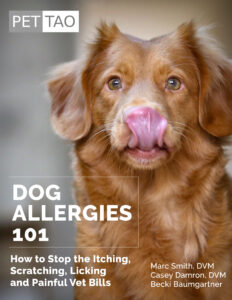 Identifying gastrointestinal issues in dogs can often indicate an underlying allergic reaction to specific food components, including proteins or grains. Pet owners must closely monitor their dog’s eating habits and watch for any stool consistency or digestive behavior alterations. Consulting with a veterinarian is crucial to pinpoint and manage potential food allergies effectively, promoting the dog’s overall health and well-being. If you suspect your dog may be experiencing dog allergies, seeking professional guidance is critical to providing the best care possible.
Identifying gastrointestinal issues in dogs can often indicate an underlying allergic reaction to specific food components, including proteins or grains. Pet owners must closely monitor their dog’s eating habits and watch for any stool consistency or digestive behavior alterations. Consulting with a veterinarian is crucial to pinpoint and manage potential food allergies effectively, promoting the dog’s overall health and well-being. If you suspect your dog may be experiencing dog allergies, seeking professional guidance is critical to providing the best care possible.
Is your dog struggling with allergies? Learn how to ease their discomfort and boost their overall well-being with expert advice from holistic TCVM veterinarians. This comprehensive ebook on dog allergies provides practical at-home solutions to manage your dog’s symptoms effectively. Take advantage of the opportunity to download this invaluable resource instantly for a limited time. Co-authored by Dr. Casey Damron of White Oak Animal Hospital, this guide is your key to supporting your furry friend’s health and happiness.
GET “DOG ALLERGIES 101” FOR FREE
 Addressing dog allergies is crucial for the well-being of your furry friend. We understand the importance of finding practical solutions at White Oak Animal Hospital. With over 28 years of experience, our team is dedicated to providing comprehensive care. We offer integrative options not found elsewhere, including TCVM Telemedicine consultations. We encourage you to consider seeking help from our experienced professionals. Your dog’s health is our priority, and we’re here to help you every step of the way.
Addressing dog allergies is crucial for the well-being of your furry friend. We understand the importance of finding practical solutions at White Oak Animal Hospital. With over 28 years of experience, our team is dedicated to providing comprehensive care. We offer integrative options not found elsewhere, including TCVM Telemedicine consultations. We encourage you to consider seeking help from our experienced professionals. Your dog’s health is our priority, and we’re here to help you every step of the way.
Frequently Asked Questions
What are the common signs of dog allergies?
Common signs of dog allergies include itching, redness, rashes, sneezing, coughing, and gastrointestinal issues such as vomiting or diarrhea.
Can dog allergies be cured completely?
While dog allergies cannot be completely cured, they can be effectively managed through various treatments and lifestyle changes. Identifying and avoiding allergens, medication, and immunotherapy are some strategies for managing dog allergies.
Are specific dog breeds more prone to allergies?
Certain dog breeds, such as retrievers, terriers, and bulldogs, are more prone to allergies due to genetic predispositions. However, allergies can affect dogs of any breed.
Related Posts
-
How To Deal With Dog Allergies
Dealing with dog allergies isn’t as complicated as it seems. Once you and your veterinarian…
-
Effective Relief For Allergic Dog Symptoms
An allergic dog is easy to spot! Sure, all dogs itch and scratch, but you…
-
How To Use A Dog Allergy Blood Protein Supplement
Does your pet suffer from common dog allergy symptoms? Your pup may experience: Itching and…
-
Two Effective Natural Remedies for Dogs with Allergies
Dogs with allergies are tough to treat! The dog allergy game plan is relieving symptoms.…


